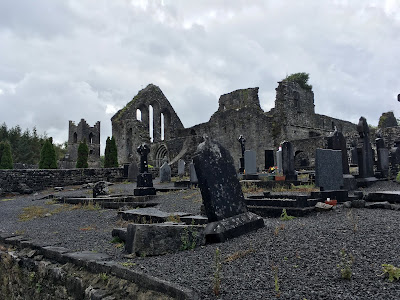Everywhere in Britain and Ireland, there seem to be ruined stone churches, cottages, towers, and especially in this part of the country, literally around every corner. History lasts for centuries when it is immortalized in stone.
We stopped for lunch in Cong in County Mayo, a pretty little village on the River Cong. We spent some time looking at more ruins: the 12th century Cong Abbey, built on the site of a 7th century monastery.
Somehow these photos don't capture the feeling of awe as one steps through ruined arches still standing after so many centuries, or tiptoes reverently around big flat tombstones in the churchyard where the bones of anonymous holy men are interred.
Then we rounded a corner and incongruously came across this statue of a familiar American movie star of the last century, John Wayne, manfully cradling a slim Maureen O'Hara in his arms.
The statue is dedicated those involved in the production of the 1952 movie The Quiet Man, which was filmed in this area. I take it that the statue is the climactic and happy ending to the movie, which I have not seen. I found a trailer for the it on You Tube and watched it, but honestly, it seemed too dated and corny to warrant watching the entire movie merely to view the splendid scenery.
From here we passed through countryside fenced with miles and miles of stone walls, continuing education for an amateur stonemason like me. Rivers cascaded down from the mountains to the east.
This part of Ireland is called the Connemara Region, and it is known for its fine marble which has been used in buildings around the world. It is supposed to have forty shades of green, and also many other colors, ranging from red to white to black. We stopped at the quarry and watched a short presentation on how the marble is quarried and worked.
Some of the marble is so hard that it is used in semi-precious jewelry, and the shop had some beautiful (and expensive) samples on display. The green looks very much like jade.
Across the street was a Visitors Center, and as we entered we could smell the sweet and distinctive fragrance of burning peat. It is an interesting fuel, unlike any kind of wood or coal that I have used over many decades coaxing heat from wood-burning fireplaces and stoves. Despite being harvested in a bog, it has a high carbon content and burns surprisingly well. Steve told us that, in a way, it was a fuel halfway to becoming coal.
We arrived in Galway late in the afternoon and had time to explore another interesting, bustling city, with cobbled pedestrian-friendly streets.
Galway was founded by fourteen merchant families; they were the families of Athy, Blake, Bodkin, Browne, D'Arcy, Deane,
Font, Ffrench, Joyce, Kirwan, Lynch, Martin, Morris and Skerritt. The family flags hang around the central square where our coach parked.
There was Joyce, whose family originated in this area. And there was also Morris, my Mother's maiden name. My mother worked on her genealogy for years but did not go back this far; she only knew that she was Scotch-Irish. So I have roots in this part of Ireland, too.
We walked down along the River Corrib to view the Roman Catholic Galway Cathedral (formally The Cathedral of Our Lady Assumed into Heaven and St Nicholas) and I was surprised to learn that it was constructed not in 965 but in 1965.
Our lodging for the night was the Connact Hotel, in the heart of everything in Galway - cobbled streets, restaurants, and shops meandering busily down to the River in an area called the Latin Quarter. So many of these cities in Ireland are very cosmopolitan, Thai and Italian and Chinese restaurants rubbing elbows companionably.
We have been enjoying getting to know our fellow travelers even more, and have been trying to sit with different ones at dinner and breakfast. Today I chatted with Gary, a retired engineer from the Mayo Clinic in Minnesota. I found out that he had designed and built an innovative underground house, and also had built a log cabin vacation home out in the country and done most of the work himself. We traded stone-masonry tales!
I was delighted to see this sign (in Gaelic and English) painted on the wall in the lobby of the Connact Hotel, which applies to so many of us on this tour.
I hope readers of this blog are enjoying these tales!














No comments:
Post a Comment